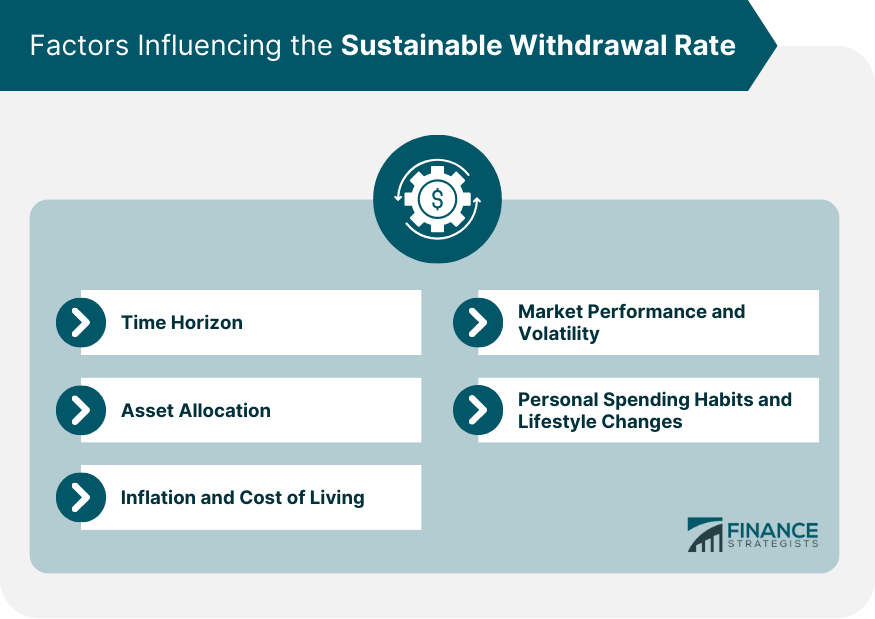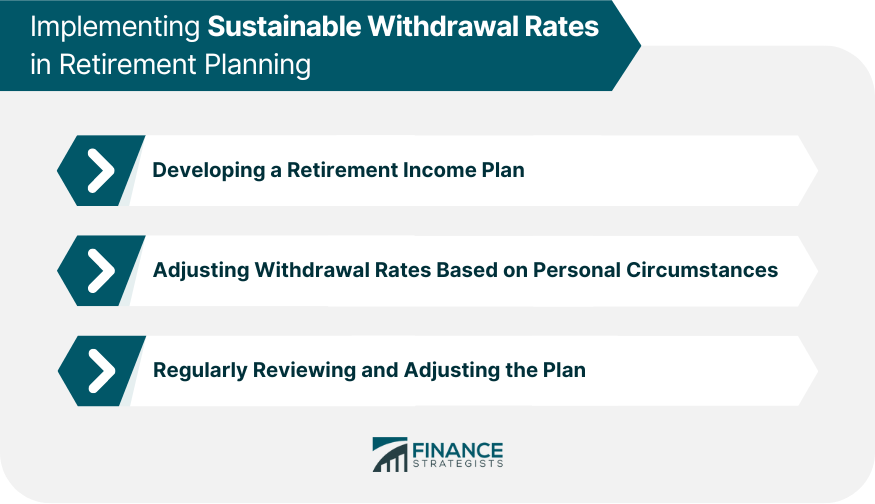The sustainable withdrawal rate (SWR) refers to the amount of money that can be withdrawn annually from a retirement portfolio without significantly reducing the principal balance over the long-term. The SWR is usually expressed as a percentage of the portfolio's initial value and is determined by a number of factors, including the retiree's investment strategy, retirement goals, and expected lifespan. It is important to note that the SWR is not a fixed number but rather a dynamic one that can change over time depending on market conditions and the retiree's personal circumstances. For example, if someone has a retirement portfolio of $1 million and decides to withdraw 4% or $40,000 in the first year of retirement, and adjust this amount annually for inflation, then this is considered to be a 4% sustainable withdrawal rate. The idea is to have a withdrawal rate that is high enough to support the retiree's lifestyle but not so high that it depletes the portfolio too quickly. SWR plays a crucial role in retirement planning, as it determines the amount that can be withdrawn from a retirement portfolio each year without depleting the portfolio prematurely. Ensuring a secure retirement requires understanding the importance of SWR and its impact on financial stability during retirement. The time horizon, which includes the duration of retirement and life expectancy, influences the SWR. Individuals with longer retirement periods may need to adopt a lower SWR to avoid running out of funds. A well-diversified portfolio containing stocks, bonds, cash, and other investments can impact the SWR. A higher proportion of stocks may lead to higher potential returns but also increased volatility, whereas a more conservative asset allocation with bonds and cash can provide stability at the expense of lower returns. Inflation and changes in the cost of living can affect the real value of withdrawals. It is crucial to adjust the withdrawal rate for inflation to maintain purchasing power throughout retirement. Market performance and market volatility influence the sustainability of a withdrawal rate. During periods of market decline, higher withdrawal rates can deplete a portfolio more rapidly. Spending habits and lifestyle changes during retirement can impact the withdrawal rate. A more frugal lifestyle may allow for a lower withdrawal rate, while increased expenses due to travel, health care, or other factors may require a higher rate. The 4% Rule, originating from the Trinity Study, suggests that withdrawing 4% of a retirement portfolio's initial balance, adjusted for inflation, results in a high probability of not depleting the portfolio over a 30-year retirement. However, this rule has several limitations: Historical Data Limitations: The 4% Rule is based on historical data, which may not accurately predict future market conditions. Changing Market Conditions: Low-interest rates and market fluctuations can render the 4% Rule less reliable. Longevity Risk: The 4% Rule assumes a 30-year retirement, but longer lifespans could result in portfolio depletion. Ignoring Personal Circumstances: The rule does not account for individual spending habits, lifestyle changes, or specific investment allocations. Monte Carlo simulations can provide a range of potential SWR scenarios based on various market conditions and investment allocations. This method helps assess the probability of portfolio depletion under different circumstances. By analyzing historical market data, investors can estimate how different withdrawal rates would have performed in the past. Although past performance is not indicative of future results, this method can provide insight into how various SWR strategies might fare in different market environments. Flexible withdrawal strategies can help adapt to changing market conditions and personal circumstances. Some examples include: Constant Inflation-Adjusted Spending: Adjusting withdrawals annually for inflation while maintaining a constant spending level. Percentage of Remaining Portfolio: Withdrawing a fixed percentage of the remaining portfolio each year. Guardrails Approach: Adjusting withdrawal rates based on predetermined portfolio value thresholds. Required Minimum Distributions (RMDs): Following IRS guidelines for RMDs from retirement accounts, which provide a structured withdrawal schedule. Annuities and other guaranteed income streams can supplement retirement income and help reduce the risk of portfolio depletion. These products can provide a predictable income, allowing for a more conservative SWR in the remaining portfolio. A comprehensive retirement income plan involves identifying retirement goals and priorities, estimating retirement expenses, and determining income sources. By understanding these factors, individuals can create a personalized plan to meet their financial needs during retirement. Each individual's financial situation, investment preferences, and spending habits are unique. As a result, adjusting the SWR according to personal circumstances is essential for creating a sustainable retirement income plan. Ongoing monitoring of investment performance, personal circumstances, and market conditions is vital for maintaining a sustainable withdrawal rate. By regularly reviewing and adjusting the retirement plan, individuals can adapt to changes and ensure long-term financial stability. A thorough understanding of the Sustainable Withdrawal Rate and its significance in retirement planning is essential for maintaining financial security throughout retirement. By considering factors such as time horizon, asset allocation, inflation, market performance, and personal spending habits, individuals can determine an appropriate SWR for their unique situation. Alternatives to the 4% Rule, such as Monte Carlo simulations, historical data simulations, flexible withdrawal strategies, and annuities, offer additional options for creating a personalized and sustainable retirement income plan. Regularly reviewing and adjusting the plan in response to changes in personal circumstances and market conditions ensures that retirees can enjoy financial stability throughout their retirement years.What Is the Sustainable Withdrawal Rate?
Factors Influencing the Sustainable Withdrawal Rate
Time Horizon
Asset Allocation
Inflation and Cost of Living
Market Performance and Volatility
Personal Spending Habits and Lifestyle Changes

The 4% Rule and Sustainable Withdrawal Rate
Alternative Methods for Determining the Sustainable Withdrawal Rate
Monte Carlo Simulations
Historical Data Simulations
Flexible Withdrawal Strategies
Annuities and Guaranteed Income Streams
Implementing Sustainable Withdrawal Rates in Retirement Planning
Developing a Retirement Income Plan
Adjusting Withdrawal Rates Based on Personal Circumstances
Regularly Reviewing and Adjusting the Plan

Conclusion
Sustainable Withdrawal Rate FAQs
A sustainable withdrawal rate (SWR) is the amount of money an investor can withdraw annually from their portfolio while preserving its value over time. The SWR is usually expressed as a percentage of the portfolio's initial value and is adjusted annually for inflation.
A sustainable withdrawal rate is important because it helps retirees determine how much they can safely withdraw from their portfolio without running out of money during their retirement years. The SWR provides a framework for making retirement income decisions and helps retirees create a long-term financial plan that will meet their needs.
The SWR is typically calculated using historical market data and assumes a certain level of risk. A commonly used SWR is 4%, which assumes a moderate level of risk and a diversified portfolio. The SWR is then adjusted annually for inflation.
Several factors can affect a sustainable withdrawal rate, including inflation, market volatility, interest rates, investment returns, and the length of the retirement period. Higher inflation, market volatility, and longer retirement periods can decrease the SWR, while higher investment returns and lower inflation can increase the SWR.
Some financial experts argue that the 4% rule may no longer be valid due to changing economic conditions, such as lower expected investment returns and longer life expectancies. However, many financial planners still use the 4% rule as a starting point for retirement planning.
True Tamplin is a published author, public speaker, CEO of UpDigital, and founder of Finance Strategists.
True is a Certified Educator in Personal Finance (CEPF®), author of The Handy Financial Ratios Guide, a member of the Society for Advancing Business Editing and Writing, contributes to his financial education site, Finance Strategists, and has spoken to various financial communities such as the CFA Institute, as well as university students like his Alma mater, Biola University, where he received a bachelor of science in business and data analytics.
To learn more about True, visit his personal website or view his author profiles on Amazon, Nasdaq and Forbes.















